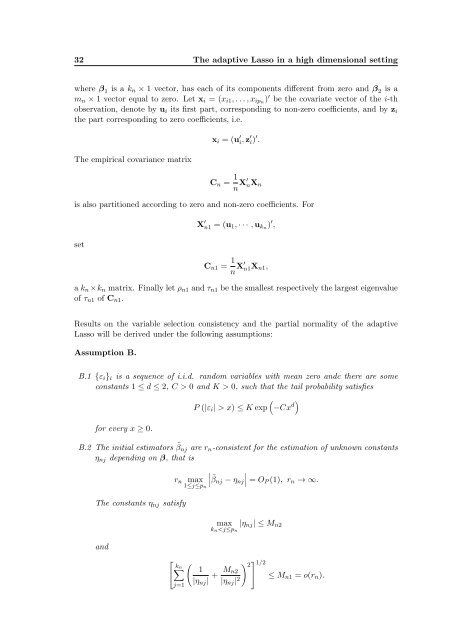Subsampling estimates of the Lasso distribution.
Subsampling estimates of the Lasso distribution.
Subsampling estimates of the Lasso distribution.
Create successful ePaper yourself
Turn your PDF publications into a flip-book with our unique Google optimized e-Paper software.
32 The adaptive <strong>Lasso</strong> in a high dimensional setting<br />
where β 1 is a k n × 1 vector, has each <strong>of</strong> its components different from zero and β 2 is a<br />
m n × 1 vector equal to zero. Let x i = (x i1 , . . . , x ipn ) ′ be <strong>the</strong> covariate vector <strong>of</strong> <strong>the</strong> i-th<br />
observation, denote by u i its first part, corresponding to non-zero coefficients, and by z i<br />
<strong>the</strong> part corresponding to zero coefficients, i.e.<br />
The empirical covariance matrix<br />
x i = (u ′ i, z ′ i) ′ .<br />
C n = 1 n X′ nX n<br />
is also partitioned according to zero and non-zero coefficients. For<br />
X ′ n1 = (u 1 , · · · , u kn ) ′ ,<br />
set<br />
C n1 = 1 n X′ n1X n1 ,<br />
a k n ×k n matrix. Finally let ρ n1 and τ n1 be <strong>the</strong> smallest respectively <strong>the</strong> largest eigenvalue<br />
<strong>of</strong> τ n1 <strong>of</strong> C n1 .<br />
Results on <strong>the</strong> variable selection consistency and <strong>the</strong> partial normality <strong>of</strong> <strong>the</strong> adaptive<br />
<strong>Lasso</strong> will be derived under <strong>the</strong> following assumptions:<br />
Assumption B.<br />
B.1 {ε i } i is a sequence <strong>of</strong> i.i.d. random variables with mean zero andc <strong>the</strong>re are some<br />
constants 1 ≤ d ≤ 2, C > 0 and K > 0, such that <strong>the</strong> tail probability satisfies<br />
for every x ≥ 0.<br />
P (|ε i | > x) ≤ K exp<br />
(−Cx d)<br />
B.2 The initial estimators ˜β nj are r n -consistent for <strong>the</strong> estimation <strong>of</strong> unknown constants<br />
η nj depending on β, that is<br />
r n<br />
The constants η nj satisfy<br />
∣ ∣ ∣∣ ∣∣<br />
max ˜βnj − η nj = OP (1), r n → ∞.<br />
1≤j≤p n<br />
max<br />
k n
















